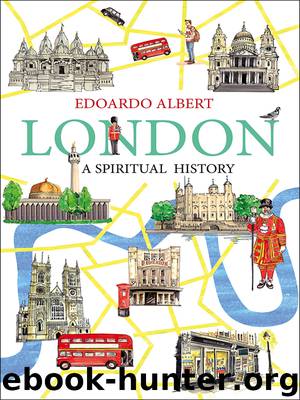London by Edoardo Albert

Author:Edoardo Albert
Language: eng
Format: epub
Publisher: Lion Hudson
Published: 2016-02-03T16:00:00+00:00
As to the question whether there is such an existent Being as an atheist, to put that out of all manner of doubt, I do declare upon my honour that I am one. Be it therefore for the future remembered, that in London in the kingdom of England, in the year of our Lord one thousand seven hundred and 81, a man has publickly declared himself an atheist.44
The public atheist was probably a physician named Matthew Turner, and thus solidly a member of the middle classes. But the slowly building core of atheism in the later eighteenth and the nineteenth centuries had little to do with the upper or middle classes. It was rather a function of the huge disruptions and movements of the eighteenth and nineteenth centuries, as land was enclosed and a landless pool of labour created that found work in the newly industrializing towns of the north and, although this is seldom acknowledged, London too. Taken from the rhythms and conventions of rural life, and the pressure to conform exerted by gentry and neighbours, religious habits just… melted away.
In fact, if ever there was convincing proof of the idea that human beings are fallen creatures it lies in this: we shuck off good habits with barely a backwards glance – indeed, we feel a certain relief at their loss – but bad habits can hardly be shifted, despite employing all the strength and will available to us. The population movements of the eighteenth and nineteenth centuries confirm this: taken from their homes and communities, people abandoned their old ways and beliefs as easily as they shook the cowpats from their feet.
When, in the nineteenth century, reformers started to investigate the religious habits of poor Londoners, they were appalled. It wasn’t really that the new working class disbelieved in God; rather that he, at least as he was presented to them by the church, appeared irrelevant. The City of London was well served – probably overserved – with churches, but the same was not true of London’s ever-spreading suburbs. Between 1730 and 1815, when the city was growing fast, only ten or so new churches were built to serve the new urban areas. As early as 1786, reformers had noted “the great estrangement that has taken place between the lower orders of people and their parochial ministers”.45 But, in 1851, there came the evidence to back up the general suspicion that, somehow, faith had leaked away from the working classes inhabiting Britain’s newly industrialized cities and, in particular, London.
The 1851 Census of Religious Worship investigated every place of worship in the country, including nonconformist chapels, synagogues, and Catholic churches. The survey was done alongside the national census that was being carried out at the same time, and asked the respondents how many people (adults and children) attended church on Sunday, 30 March 1851. The churches were also asked whether this figure differed significantly from normal, when the church had been built, and how many people it could accommodate.
Once
Download
This site does not store any files on its server. We only index and link to content provided by other sites. Please contact the content providers to delete copyright contents if any and email us, we'll remove relevant links or contents immediately.
Waking Up in Heaven: A True Story of Brokenness, Heaven, and Life Again by McVea Crystal & Tresniowski Alex(37639)
Still Foolin’ ’Em by Billy Crystal(36257)
Cecilia; Or, Memoirs of an Heiress — Volume 1 by Fanny Burney(32408)
Cecilia; Or, Memoirs of an Heiress — Volume 3 by Fanny Burney(31813)
Cecilia; Or, Memoirs of an Heiress — Volume 2 by Fanny Burney(31787)
Fanny Burney by Claire Harman(26506)
Empire of the Sikhs by Patwant Singh(22957)
We're Going to Need More Wine by Gabrielle Union(18947)
Hans Sturm: A Soldier's Odyssey on the Eastern Front by Gordon Williamson(18453)
Plagued by Fire by Paul Hendrickson(17313)
Out of India by Michael Foss(16776)
All the Missing Girls by Megan Miranda(15478)
Cat's cradle by Kurt Vonnegut(15145)
Pimp by Iceberg Slim(14306)
Molly's Game by Molly Bloom(14045)
Bombshells: Glamour Girls of a Lifetime by Sullivan Steve(13949)
Leonardo da Vinci by Walter Isaacson(13139)
For the Love of Europe by Rick Steves(12578)
4 3 2 1: A Novel by Paul Auster(12260)
